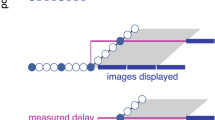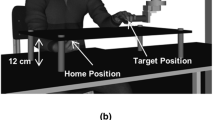Abstract
A trial-by-trial analysis was used to systematically examine the influence of switching visual conditions on visual feedback utilization for a manual aiming movement. In experiment one, vision was randomly manipulated from trial to trial with no more than four consecutive trials in the same visual condition. In experiment two, participants were provided with certainty of visual feedback availability prior to every trial. Results of both studies revealed that movement endpoint variability was most associated with visual feedback availability on the previous trial. Furthermore, correlation analyses comparing movement trajectory at 25, 50 and 75% with movement end (i.e. 100%) revealed that the efficiency of online corrections also depends on the availability of visual feedback on the previous trial. These results suggest that the accuracy of an aiming movement is highly dependent on processing of offline visual information from the preceding trial.




Similar content being viewed by others
Notes
It must be acknowledged that one limitation to our study is the fact that only one (1) target was used throughout the experiment. As such, the control strategies for planning and online control may be different when multiple targets are presented. We thank an anonymous reviewer for pointing out this limitation.
We thank an anonymous reviewer for directing us towards these corroborating studies.
References
Beggs WD, Howarth CI (1972) The movement of the hand towards a target. Q J Exp Psychol 24:448–453
Bernier PM, Chua R, Franks IM, Khan MA (2006) Determinants of offline processing of visual information for the control of reaching movements. J Mot Behav 38:331–338
Elliott D, Allard F (1985) The utilization of visual feedback information during rapid pointing movements. Q J Exp Psychol A 37:407–425
Elliott D, Carson RG, Goodman D, Chua R (1991) Discrete vs. continuous visual control of manual aiming. Hum Mov Sci 10:393–418
Elliott D, Hansen S, Mendoza J, Tremblay L (2004) Learning to optimize speed, accuracy and energy expenditure: A preliminary model of goal-directed aiming. J Mot Behav 36:339–351
Heath M (2005) Role of limb and target vision in the online control of memory-guided reaches. Motor Control 9:281–309
Keele SW, Posner MI (1968) Processing of visual feedback in rapid movements. J Exp Psychol 77:155–158
Khan MA, Elliott D, Coull J, Chua R, Lyons J (2002) Optimal control strategies under different feedback schedules: Kinematic evidence. J Mot Behav 34:45–57
de Lussanet MHE, Smeets JBJ, Brenner E (2002) The relation between task history and movement strategy. Behav Brain Sci 129:51–59
Messier J, Kalaska JF (1999) Comparison of variability of initial kinematics and endpoints of reaching movements. Exp Brain Res 125:139–152
Meyer DE, Abrams RA, Kornblum S, Wright CE, Smith JEK (1988) Optimality in human motor performance: Ideal control of rapid aimed movements. Psychol Rev 95:340–370
Plamondon R, Alimi AI (1997) Speed/accuracy trade-offs in target-directed movements. Behav Brain Sci 20:279–303
Song J-H, Nakayama K (2007) Automatic adjustment of visuomotor readiness. J Vis 7:1–9
Woodworth, RS (1899) The accuracy of voluntary movement. Psychol Rev 3(3 suppl 13):1–119
Zelaznik HN, Hawkins B, Kisselburgh L (1983) Rapid visual feedback processing in single-aiming movements. J Mot Behav 15:217–236
Author information
Authors and Affiliations
Corresponding author
Additional information
This study was supported by a grant from the Natural Sciences and Engineering Research Council of Canada (NSERC) awarded to Luc Tremblay.
Rights and permissions
About this article
Cite this article
Cheng, D.T., Luis, M. & Tremblay, L. Randomizing visual feedback in manual aiming: reminiscence of the previous trial condition and prior knowledge of feedback availability. Exp Brain Res 189, 403–410 (2008). https://doi.org/10.1007/s00221-008-1436-3
Received:
Accepted:
Published:
Issue Date:
DOI: https://doi.org/10.1007/s00221-008-1436-3




